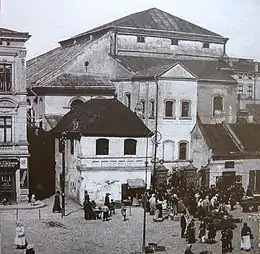Podgórski sisters
The Podgórski sisters, Stefania Podgórska (June 2, 1925 – September 29, 2018) and Helena Podgórska (born 1935), came from a Catholic farming family living near Przemyśl in south-eastern Poland.[1] During the Holocaust, sixteen-year-old Stefania and her seven-year-old sister harboured thirteen Jewish men, women and children in the attic of their home for two-and-a-half years. Both were later honored as the Righteous Among the Nations by Yad Vashem as well as by the Jewish and Polish organizations in North America, for their wartime heroism.[2]

Before the 1939 invasion of Poland by Nazi Germany and the Soviet Union, Stefania Podgórska (Born June 2, 1925 in Lipa - Died September 29, 2018 in Los Angeles) worked in a grocery store owned by the Diamants, a Jewish family.[3] Her father had died in 1938 after an illness. Soon after the arrival of the Nazis, her mother and brother were taken to Germany for forced labor, while the Diamants were forced into a ghetto. The two Podgórski sisters lived in Przemyśl alone in an apartment rented by Stefania, who was 17 at the time.[4] She got a job in town as a machine-tool operator.
The border between the two invaders ran through the middle of Przemyśl until the German attack on the Soviet Union in June 1941. In 1942 the news spread about the Jewish Ghetto in Przemysl being liquidated by the Nazis.[1] Stefania's prewar employer's son, Max Diamant, appeared on their doorstep. He escaped with his brother and cousin from the train to Belzec extermination camp.[5] The girls were terrified, but gave Max permission to hide in the attic. He contacted his family in the Ghetto, and asked Stefania to accept them also, including his younger brother Henek and Henek's wife Danuta, Dr. William Shylenger and his daughter Judy, and a friend of his, a dentist with his son. In order to accommodate the fugitives Stefania soon rented a semi-detached cottage with two rooms, a kitchen and an attic, on Tatarska Street.
Life on Tatarska Street
Helena with her sister Stefania moved in first, followed by Max Diamant. Then came Dr. Shylenger with his daughter, and the dentist with his son. The dentist's friend, a widow from the ghetto came also with her son and daughter. She wrote a threatening note that she would denounce the girls if she was refused. The dentist begged Stefania to admit his nephew with his wife. Max's younger brother, Henek, with his wife arrived later, finally there came a Jewish mailman: thirteen Jews in total. Max made a wall in the attic from boards bought by Stefania, securing a sleeping quarter for everybody.
After a few weeks they were completely without money. Stefania started to knit sweaters and take orders for them, from her friends and acquaintances. She was trading clothes for food and buying it, if necessary, on the black market. An SS man moved in next door. Max kept vigil with others to eliminate any noises. In early 1944 a German officer entered the apartment and announced that Stefania and Helena must vacate the place in two hours. The Jewish fugitives begged the two sisters to flee as they felt that all of them were doomed.[6] But Stefania - after praying to the Black Madonna of Częstochowa - thought otherwise. "I am not leaving you", she said. German nurses and their boyfriends lived underneath Stefania and her refugees for eight months. After these eight months, the nurses had to evacuate to follow the German army; the 13 Jewish residents had successfully stayed undetected.[7]
On July 27, 1944, the Soviet Army entered Przemyśl. The thirteen Jews, though emaciated and weak, were free. Max, who took the name Josef Burzminski, proposed to Stefania (Fusia) and was accepted.[7] In 1961 the couple emigrated to the United States, where Burzminski became a dentist.[1] They have a son and daughter. Helena Podgórska remained in Poland, married and became a physician in Wrocław. In 1979 the sisters were honored by Yad Vashem, in Jerusalem, as Righteous among the Nations.
Stefania died on September 29, 2018 at the age of 97 in Los Angeles, California.[8]
In popular culture
A television movie called Hidden in Silence which tells their story, was made in 1996 by Richard A. Colla with screenplay by Stephanie Liss, featuring Kellie Martin as Fusia (Stefania), Gemma Coughlan as Helena, and Tom Radcliffe as Max.[9]
Notes
- Podgorska Stefania (1925) at www.podgourski.net via Internet Archive.
- Margaret Walden, "Teacher's Guide", Richland School District 2, Columbia, South Carolina. Video Synopsis: Josef Burzminski, The Other Side of Faith. Archived 2011-03-30 at the Wayback Machine South Carolina ETV. Retrieved 27 January 2012.
- Garry Buff "Stefania (Fusia) Podgorska, Poland" at Raoul Wallenberg Foundation
- Holocaust Encyclopedia, Stefania Podgorska and her younger sister Helena. United States Holocaust Memorial Museum via Internet Archive.
- Atwood 2011, p. 51.
- Atwood 2011, p. 54.
- Atwood 2011, p. 55.
- "Obituary – Stefania Podgorska Burzminski". Archived from the original on 2018-12-02. Retrieved 2018-12-02.
- "Hidden in Silence (1996)". IMDb. Retrieved 11 November 2013.
References
- Atwood, Kathryn (2011). Women Heroes of World War II. Chicago: Chicago Review Press. ISBN 9781556529610.CS1 maint: ref=harv (link)
- Podgorska Stefania (1925) at Podgorski Family Club webpage, including photographs.
- Stefania and her younger sister Helena Podgorska, United States Holocaust Memorial Museum, Washington, D.C., 2008.
- Interview with Stefania, United States Holocaust Memorial Museum, Washington, D.C., 1989.
- Margaret Walden, Video Synopsis ETV. The Other Side of Faith. Teacher's Guide: Richland School District 2, Columbia, South Carolina.
- The Podgórski sisters - their activity to save Jews' lives during the Holocaust, at Yad Vashem website.
- https://web.archive.org/web/20181202070720/https://holocaustheroine.com/obituary/obituary/ - Stefania Podgorska Burzminski Obituary, 2018.
Further reading
- Thomas Fleming, "Did the children Cry?" Reader's Digest, February 1996.
- Adler, Morris, Jewish Heritage Reader, Taplinger Publishing Co., Inc., 1965.
- Lerski, George, and Halina Lerski, Jewish-Polish Coexistence, 1772–1939, Greenwood Press, 1986.
- Vishniac, Roman, and Elie Wiesel, A Vanished World, Noonday Press, 1986.